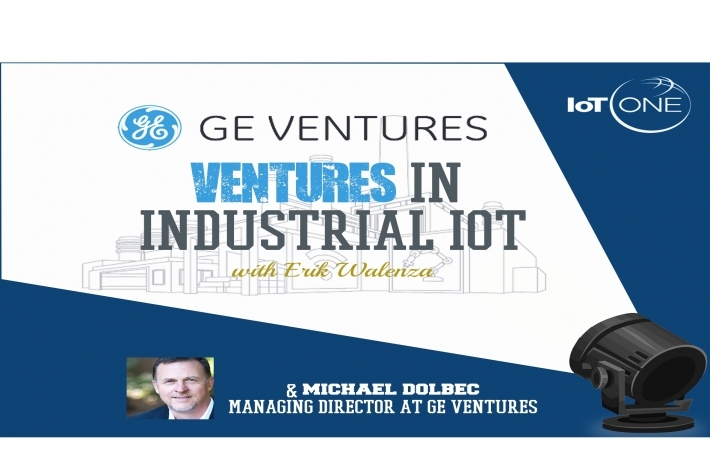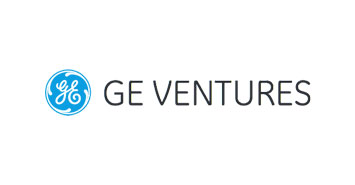
Published on 12/11/2017 | IoT Index
This is an episode of the "Ventures in Industrial IoT" series brought to you by GE Ventures. In the series we explore success factors and challenges in Industrial IoT markets with CEOs, investors and experts.

IoT Spotlight Podcast introduction:
The IIoT Spotlight Podcast shines a light on Industrial IoT solutions that are impacting businesses today. Every episode we interview an expert about a specific IoT use case. Our goal is to provide insight into the planning and implementation of IIoT systems, from new business models to technology architecture selection to data ownership and security. The IIoT Spotlight is produced by IoT ONE, an information platform that provides market insight, partner development, and go-to-market support for technology providers, end users, and investors. Don't forget to follow us on twitter. You can contact me directly at erik.walenza@iotone.com.
Summary:
Never has there been a trend in recent times that has been reshaping the industrial world quite as much as digitalization. and as such many firms have embarked on a digitalization strategy of their own. However, the digital transformtion race is a competitive one and many firms are finding themselves on the losing end of this race.
In the fourth installment of the "Ventures in Industrial IoT series" brought to you by GE Ventures, we welcome back Michael Dolbec, Managing Director of venture investments and M&A at GE Digital who will be discussing with us how firms can better prepare themselves to overcome bottlenecks in the process and set themselves up for success.
Learn more GE Digital: https://www.ge.com/digital/
Learn more about GE Ventures: www.geventures.com
Links:
Libsyn: http://directory.libsyn.com/episode/index/id/6031759
iTunes: https://itunes.apple.com/us/podcast/industrial-iot-spotlight/id1228185407?mt=2
Speaker bio:

Michael Dolbec is the Managing Director of Digital Strategy, Venture Investments and M&A at GE Digital. He is also an investor with Alchemist Accelerator and with i3 Equity Partners as well as a board observer on Foghorns Systems, DataTorrent, Mocana, MAANA and Ayasdi.
Michael is passionate about transforming big ideas into successful innovations, products and services. He develops partner eco-systems around technology platforms and helps companies grow via partnerships, investments and acquisitions.
Company Overview:

GE Digital is working with more than 10,000 software engineers across several of their business divisions to ensure that their customers in all sectors can tap into the power of the Industrial Internet. Their approach is built around a common software platform, agile development and shared services. By combining the nimbleness of a Silicon Valley startup with the strong pedigree of GE’s global expertise, GE Digital stands alone.
Blurbs:
“Does your company have a real digital transformation initiative: that’s usually code for they’re serious.”
"The challenge in industrial is that particularly in some aspects like cybersecurity some customers are super super conservative and they cannot put any ol’ thing into because the business continuity of the company they work for is at stake"
"They [Industrial IoT companies] go arm in arm to the customer and say what they sell is the outcome, actually the guarantee of improvement and they sell consultively to the senior executives of the company who don't care how something works."
"Our customers are essentially trading off the value of no unplanned downtime and optimized business outcomes with the risk of exposure because the more things that are hooked up to the net and the attack surface is more exposed."
"Security is something you think about as you design a new product, not as an afterthought."
Show Transciption:
[00:00:32]
Welcome back to the Industrial IoT Spotlight podcast. I am joined again by Mike Dolbec.
[00:00:38]
Mike is managing director of venture capital and M&A at G.E. Digital. Today we are going to the second part of our conversation with Mike will be discussing challenges and opportunities in the industrial IoT space from the end user adoption perspective. Mike has a depth of experience in assessing end user behavior as an investor in IoT startups and through a long career in as a technologist and investor. Our last podcast with Mike. We discuss what's hot versus what's hype so please look back at that previous podcast. Our next on Friday we'll be looking at partnering and beyond venture.
[00:01:15]
Let's kick off now. Mike looking at challenges and opportunities from the adoption side. Maybe as a starting point. What are the challenges that you see traditional companies face in terms of identifying and selecting in implementation. IoT technologies and let's look at it. I mean certainly there's the technical side but there's also the organizational side.
[00:01:39]
I'm interested in your perspective and in that aspect as well.
[00:01:43]
I have to be careful here because as an investor I'm not an entrepreneur in this particular scenario. So I'm an investor in companies that are dealing with this issue. Someone once removed and I have a perspective that comes from my investments which may not be representative of everybody's investments. So in my investments I'm trying to qualify my answer so that it doesn't sound like I'm speaking for you know all companies I invest in companies that are bound to become the dearly hope they'll be finished their product and finish whatever they're doing and become strategic to GE the way we hope they they will be. So the commercial adoption thing is kind of built into our investment diligence process and then management of the company post investment in some ways as far as GE's relationship with the company. It's a never ending process but it's carefully managed and nurtured over time. If you ask me Hey Mike what challenges do your investments see as they try and engage with customers and then grow their revenue. Perhaps that's an easier thing for me to answer abstractly. I'd say it varies quite widely by each company and their particular situation. So it's an enterprise sale almost always in fact in every case it's an enterprise sale or an industrial sale. The sales cycles the customers are generally speaking much more conservative industrial buyers at all levels don't handle high concept sales the way other people might for enterprise software. So they have to actually see a working demo often of their use case before they allow themselves to believe.
[00:03:43]
If it does what you said it was going to do and I can now work through what that's worth.
[00:03:51]
So getting into a POC (Proof Of Concept) or some sort of engagement that has a set of acceptance criteria like okay if we do this and we both agree that the result was what you were looking for then we'll take the next step. So often I think their biggest challenge is to make sure that the prospect has a number of things and they spend an extraordinary amount of time that most successful investments are how qualified customers upfront and the qualifications does vary widely. But if some version of Do you have this strategy that's relevant to my product? Do you actually have a problem? It is important that you try to solve what you have budget money to allocate towards solving. Is there a way to measure how much better my solution is than whatever way you currently do things almost always are important. Do you have access to all the data sources that would be necessary to bring into the experiment here or the evaluation in order to you know prove that the product does what it's supposed to do for you. Then there's some I think some subtle things that smart sales people understand which is do you have a sense of urgency or where are you in the life cycle of your project. But a number of companies now ask is this your company does it have a real digital transformation initiative. That's usually code for you know they're serious and OK you do great. Do you have somebody like a chief digital officer a leader who is supposed to be in charge of Journey of digital transformation. OK you do. That's great. Does that person have a plan that has you know start small and take baby steps and then start running and so forth. Okay great. You've got a plan that is there all along the way what you trying to do is qualify that people are this is more than somebody who's just curious and someone who actually acknowledges they have a problem is trying to solve it understands what solving it means and what it's worth and is capable of and willing to pay in some amount of time. So I finished this long answer with the challenge in industrial is that sometimes particularly in in some aspects of cybersecurity. Customers are super super conservative and they just can't put any old thing into production because the business continuity of the company they work for is at stake. So their evaluation cycles sometimes can be very long. typically for a company that's young and unproven and doesn't have a lot of awareness or other large company references when you're just starting out you know you get put through the ringer but eventually you get to the next stage which is what I've got all these reference customers. They've been through this with me before. You should check with them and make sure that they're happy and then I'd like to accelerate through this process because I qualified you as a prospect.
[00:07:01]
Gotcha. That's excellent excellent advice. I mean we see the significant challenge that companies have in evaluating IoT platforms for example because from a marketing perspective their feature sets are very similar. And it's it's very hard to evaluate differences in platforms without actually doing a POC. And then you get into this quite costly costly for both sides for the end user and the vendor but especially for a young company that have limited resources a high risk to take on a large number of customers if you know if they're the wrong as you said unqualified or the wrong type of customers and then invest in POCs for companies that are not a real potential customer.
[00:07:44]
I feel for those kinds of companies because each engagement has a different metrics set of metrics instead. You know what. What's the right platform for this person. It's very situational versus that company in their situation and you you don't get any efficiencies. It's tough to accelerate that process. The most novel companies I met in that with one in Germany a couple of weeks ago was very proud of saying we used to sell that way.
[00:08:14]
We used to sell our features but now.
[00:08:18]
We partnered with an insurance company. They go arm in arm to the customer and say what they sell is the outcome, actually the guarantee of improvement and they sell consultively to the senior executives of the company who don't care how something works right. They just say if we improved your efficiency or we saved you money would you be interested. Of course generally speaking the person said yes of course. How can you how can you prove to me will do that. And that's a much more interesting conversation that eventually they think they they more or less. They say okay well if we deliver X then you will share Y with us. And then the rest is just implementation. That's a much higher level sale if they don't you know my thing is faster than their thing even though that's not exactly how you compare.
[00:09:11]
You know that's interesting input.
[00:09:12]
I've talked with a small but growing number of companies that are selling to banks instead of directly to the manufacturer and so they'll find the bank that's loan to manufacture a couple of hundred million dollars and then talk to them about how they can you know make sure that they're getting an investment back by helping this company and it's a different value proposition and it's you know it's a completely different customer group or a you know a path to market but companies seem to have be having success having these financial discussions as a kickoff place with you know like you said insurance companies or banks and then using that as a partnership to go to the you know the end users end and then it's more of a technological or deployment question once you get to that point.
[00:09:57]
Mike let's look at security in particular I think this has been one of the major bottlenecks or in the past few years on the industrial side where do you feel we are today in terms of being able to confidently secure data moving to the cloud or data processed on the edge.
[00:10:15]
Well I think you're never done right. You know it's a red queen problem. To quote loosely quote Lewis Carroll an analyst in a looking glass. Right. The part of the book I'm referring to is where somebody tells Alice you have to run to stay in place and twice as fast if you want to get anywhere. So I think you are always running to stay one step ahead of the other guys. I can tell you how we think about it at GE but I can't say that there's there's no one company that does everything that's required. So you know we've humbly and soberly looked at the situation that our customers are in where they're essentially trading off the value of no unplanned downtime and optimized business outcomes. Does come at some risk of the exposure because the more things are hooked up to the net and the attack surface is more exposed. So the right way to deal with that is eyes open and understand where the risks are and address those across all the fronts at once. So you mentioned data and you said data and rest and data in motion It's also data in-use which is sort of roughly you could think about it as you know if you search for something on Google. Who else can see or search request and your search results when they come back. That's a simple analogy first you make a database request or part of your code does is the query on the answer then you're exposed somehow during the journey that may not be the kind of data you think about but that's also can be used to attack certain systems. You know we think about those issues quite a bit. We think about the issues of industrial equipment which as I said before many of those things are don't have IP addresses and they weren't originally designed thinking that you know they'd have to protect against very creative people who were trying to attack them or or the business processes they're trying to achieve. And then the other thing we try to do is say OK there's risks at lots of different levels there's risks in the devices themselves there's risks in authenticating and making sure they're still what they say they are providing even allowing them to connect to a network at risk than their risks inside the tech stack of the edge software and the cloud stack and the super services we call our own platform. The best way to attack those risks is to first acknowledge them and then second build in from the beginning be the first that you're going to have a secure design lifecycle. Security is something you think about as you design a new product not as an afterthought. You've had a leader cause you forgot and discovered some some flaw or some some chink in the armor and that's been very helpful to kind of cover that's it's a very broad subject so we will think about it all the time we think about it on behalf of our customers. We collaborate with them and with various governments there are even issues of normal cyber security systems monitor traffic they monitor what the devices are doing and they look for anomalous behavior. But how do you know the information that your monitoring system is receiving is legit. In many cases you work with many cases but certainly in some cases where industrial equipment has been attacked it's been altered in a way that it shows some operator who's casually looking at its behavior that everything's fine don't worry about me things are going great. The equivalent of a mission impossible movie where they slip in a videotape of the bank vault and you know it's empty and everything's fine. But really what's going on there. And moving around in there to take stuff out. You can't necessarily trust what you're sensing all the time universe and you know be very careful when we authenticate the information you are sensing or the information you're making business decisions on. That is really has been unaltered in some sort of legitimate audit chain back to its source.
[00:14:44]
And I think what you're describing here is an important thought process as you said. We're never going to run out of creative people that are trying to make a profit through security breaches. But as we move into a space where more devices are being connected companies just have to become more familiar with the thought process that you've just walked through of understanding where the you know the potential breaches could be the potential tactics to secure your data which are just different than they were when it was only desktop computers hooked up and you know obviously we had years of learning before we got to a place of relative stability there. Always there are breaches but companies at least attain to a level of understanding of knowing where the risks were and how to balance risk and that seems to be what we're moving towards certainly not eliminating risk but at least understanding it.
[00:15:39]
Right. And remember I want to qualify all of my comments by saying we are only one part of a very large IoT market. We're at exotic and high value assets very high business value and very high in some cases potential kinetic effects that can be created by misusing certain equipment or simple things can ruin your day like you know make a million of the wrong thing. Turn out because you change the recipe for a Kentucky Fried Chicken or whatever it is you try to make or 10 issues. I think modern hackers who attack industrial equipment don't necessarily mean to take over and take over your PC and then steal your credit card and some piece of data inside the PC they may leave a piece of industrial equipment intact and just slightly change the reason that machine is there which is to place some part in a larger manufacturing process or oil refining process or power generation process and since this process is such a tightly orchestrated ballet that if you throw one ballerina in there with a tennis racket it messes up your whole ballet. You know it is a ballerina and so sort of a strange analogy but the goal is not to mess with the ballerina. The goal is to screw up the dance. With a couple smiling ballerinas. By putting it out of balance. the results tend to be a lot worse than losing your credit card. There is a loss face that could be much more damaging to the business that operates the equipment.
[00:17:25]
And this is a good transition. Thanks for joining our discussion with Mike Dolbec the third and final segment of our conversation is going to be published this Friday.
[00:17:35]
We'll be looking at the topic of partnering beyond funding how companies like GE are working with startups not just on financing but also on issues such as providing strategic direction to guide R&D initiative so companies smaller companies are able to develop technologies to solve the real known problems as opposed to technology for technology sake and other opportunities to work together beyond the financing site. Thank you. We'll see you soon.